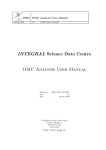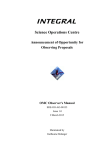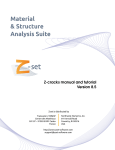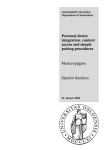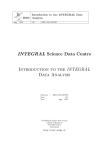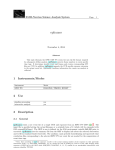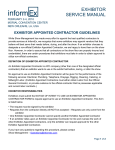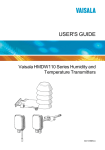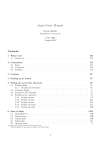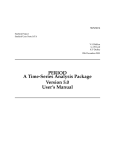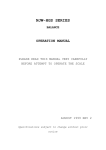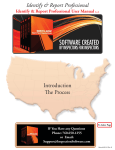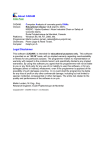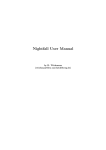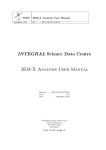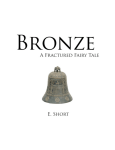Download SDAST meeting #41 Copenhagen Nov
Transcript
SDAST meeting #41 Copenhagen Nov. 24 2009 Participants: Stéphane Paltani, Erik Kuulkers, Søren Brandt, Niels Lund, Jérôme Chenevez, Niels Jørgen Westergaard. Later Carol Anne Oxborrow, Carl Budtz-Jørgensen INTEGRAL and JEM-X status (SB): JMX2 is now the default unit so JMX1 was used from revol. 170 through 855. With calibration and commissioning it amounts to more than 700 revolutions (6 years). Gain evolution: JMX1 DV setting was lowered by one step in revol 747 to 71 (~710 V). The gain increase rate (when corrected for voltage changes) has diminished. Particle trigger rate: Solar activity is still very low so the particle background makes the onboard processor very busy with event rejection (leading to higher deadtime). Calibration source decay: Cd sources are down by a factor of 30, Fe sources are down by a factor of 6. Electronic calibration: Electronics are very stable, tiny change in amplifier response, nothing to worry about. Gain profiles during an orbit: Gain correction works well. Hotspots in JMX2: A little bit of hotspot activity has been observed in JMX2 (RAWX ~ 72) at very low energies, certainly below 3 keV. The rate is quite low and its influence on the deadtime is minor. Spatial gain evolution: The Xe line has been followed in 50 revolution intervals and an evolution of the map can be tracked. These will be implemented in the IMOD IC files. Tests should be performed to see how short IMOD epochs are really required (e.g. test the Xe line shape). Radiation belt passage: INTEGRAL is coming closer and closer to the proton belt and in revolution 1020 and after it will pass very close to the peak flux. However, the passage takes only ~5 minutes and since the passage happens at belt entry and there is hope that the activation will have died off around exit (at least for JEMX where we expect little activation with effects in the pertinent energy range). News from ISDC and OSA8 comments (SP): People leaving Volker Beckmann to Paris, Bruce O’Neel to a private company. Volker has been replaced by Carlo Ferrigno for the operations. Enrico Bozzo is second operation manager. New PhDs and Post Docs, Andrii Neronov has been promoted to assistant professor. Increase in the last year around 15% of personnel. Piotr Lubinski has also left to Poland. Thierry Courvoisier is away until June 2010, Stéphane Paltani is the ad interim substitute. OSA8 is working fine after a few, now solved problems. There have been no complaints. OSA9 is pushed by Roland Walter for an ISGRI update where some glue is making unexpected shadows that are now mapped. These pixels should be removed which gives a clear improvement. People in Saclay want to make more tests. Release date could be end of February 2010, but it is uncertain. SP has started some hardware activity for Astro-H (the Japanese mission) with respect to the calorimeter. Similar activities have been started in the framework of IXO for the calorimeter and high time-resolution spectrometer. ESAC news (EK): Peter Kretschmar has now been appointed mission manager for INTEGRAL. Else it is quite a calm period. A new AO is to be issued in end of March 2010, so a documentation update will be asked for. j_ima_iros for OSA8 (NL): The j_src_ls can be forced to use source catalog position by setting FLAG=3 as input to j_ima_iros, in which case it will never put its own position. Explanation of the FLAG use in j_ima_iros: Binary FLAG interpretation 1 Copied from User Catalog FLAG 2 Copied from User Catalog FLAG 4 Source has DETSIG > 4 in search band 1 ( 3 to 7 keV) 8 Source has DETSIG > 4 in search band 2 ( 7 to 11 keV) 16 Source has DETSIG > 4 in search band 3 (11 to 20 keV) 32 Source has been found in several search bands 64 Source has been identified inside j_ima_iros with a User Catalog source (source identification in srcl_res can come from other programs as well) 1024 Source has been accepted as valid by j_ima_iros Why are some sources not found by j_ima_iros when they are clearly visible in the image? A distinction between various IROS stopping signals should be introduced (there are 14 different ways of stopping the IROS loop e.g. if the sources is deemed insignificant). With strong sources there is an increased probability for spurious peaks. SP thinks that this is a minor problem, the image can be searched by other means (e.g. j_ima_src_locator), and other strange cases will appear. (Note after meeting: The reason for this behavior has been located in the j_ima_iros code as a bug and a new version will soon be ready.) Lightcurve extraction in j_ima_iros (NL): Easier to incorporate the light curve extraction into j_ima_iros since so many features are already present there. What method to use? (NJW): (See technical note presented at the meeting). The single source approach as well as least square solution was presented and discussed. The recommendation was that the least square solution should be the baseline, but options for the single source solution and the maximum likelihood fitting – in the case of very short timebins where there are very few counts. Gain aging and Xe line (CAO): No gain aging seen for JEM-X1 since it has stabilized over its many years of use. We can however expect to see such aging in JEM-X2 now that it’s switched on. JEM-X1 does show temperature-dependant gain non-linearities that are corrected offline by the use of IC gain history tables. JEM-X2 was switched on with the wrong PHA binning table and this too will require and IC gain history table to correct it. New reference channels are also needed for JEM-X2 to ensure that ‘cool’ revolutions lie a little above 29.6keV and ‘warm’ revolutions lie somewhat under this – the difference between the two being less than 1% at the moment. CAO will keep an eye on the JEM-X2 evolution of temperature non-linearities that will probably arise as the instrument ages. Some issues with OSA8 (JC): PSFsigma in j_ima_mosaic. 0.1’ is added to the input PSFSIGMA value for expected smearing but this is too simple (1 -> 1 mosaicking is possible). The additional should increase proportionally or rather asymptotically with the number of combined images. Should PSFsigma rather be a map together with the mosaic image? Comment by SP: The effect should be properly documented and quantified before any action is taken. The current situation is not acceptable since mosaic_spec will give different results for the image and the mosaic in the case of a single ScW. SP is of the opinion that the extra 0.1’ should be removed for OSA9. A bug in j_ima_mosaic? A problem appears when the user has given parameter ‘diameter’ and asks for an exposure map, but only when using the pre-compiled executable from ISDC (OSA8). SP suggests to run ‘valgrind’ to check for memory overwriting and other loose ends. Light curve extraction and gain correction – do they work as expected? IGR J19112+1358 shows a strange lightcurve. The gain correction seems to depend on the existence of the file jmxi_gain_corr.fits. When it is not present jmxi_gain_scp.fits will be produced. SP: there is an easy fix. Detach (dal_detach gain_scp) the extension when running OSA. (Note after meeting: Mathias Beck has identified that a change in j_cor_gain has had unforeseen consequences for the j_correction script since revolution 619. There is an easy fix in j_correction and a new version will be ready for OSA9). Focus of software development (All) The light curve production in j_ima_iros is the main goal and there are really no other strong wishes. User manual and cookbook updates (JC) Lightcurve extraction at LCR level: There is a meaningless phrase in the on-line cookbook. FLAG 3 should be used for sources that the user really wants in the basic set of sources – too many of these will deteriorate the flux determination in other words allow too much noise in the fitting process. For flux/spectrum determination it is best to put FLAG=1 in order not to let the basic set of sources to grow too much. But another run with FLAG=3 for the ‘extra’ sources is recommended as a preparation for j_src_lc since in that case RA/DEC_OBS becomes equal to RA/DEC_CAT. Crab calibrations (SB, EK) Perhaps we should make a full circle at a lower off-axis angle where the full detector is illuminated. Also the Crab on axis in the beginning of an orbit could be interesting. Next Crab calibration will be in the beginning of March. Proposal must be presented to ESAC at end of January. IC table updates (NJW, CAO, SB) With OSA9 issue in beginning of 2010 it could be useful to have the IMOD SPAG tables ready (note, that there is an interaction with the Xe reference channels so re-calculation is required). No BPL nor RMF updates are known at this moment. ADD updates (JC) Input required before 2010-01-28. Do we have an official document site here at DTU Space? This question should be addressed to Allan Hornstrup. Next meeting: will be decided when more is known about the OSA9 release. 2009-12-01/NJW Action items A1_41 (NJW) Test Xe line shape with various spatial gain calibration maps A2_41 (SP) Update cookbook and ‘Known Issues’ to let it be known that j_src_lc always uses RA/DEC_OBJ in stead of RA/DEC_CAT. A3_41 (JC) Demonstrate how the PSF changes when a mosaic is been built as a function of the input images. A4_41 (NJW) Find the PSF width as a function of position in the j_ima_iros image and some examples from j_ima_mosaic. A5_41 (SP) Disseminate the solution to the GAIN-SCP issue (using ‘dal_detach … pattern=”JMXi-GAIN-SCP”’) and document it. A6_41 (JC, CAO, NJW, SP) ADD updates before 2010-01-28 to JC in .tex file format.




